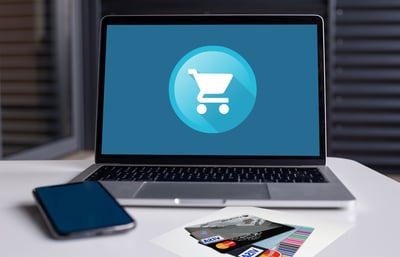
The state of logistics and the supply chain is constantly evolving, with various factors affecting the direction it takes. And companies need to respond to the latest trends in 2022 with the right logistics and supply chain strategies to keep up with this ever-changing environment.
What Are Some Strategies to Address Logistics and Supply Chain Trends in 2022?
Reinforce Partnerships
 A strong partnership between a shipper and a logistics and/or freight provider is worth its weight in gold, now more than ever. With changes abounding in the space over the past couple of years, working together with trusted partners makes it easier to manage the environment. A couple of top reasons for this in 2022:
A strong partnership between a shipper and a logistics and/or freight provider is worth its weight in gold, now more than ever. With changes abounding in the space over the past couple of years, working together with trusted partners makes it easier to manage the environment. A couple of top reasons for this in 2022:
- Shippers better understand where they fit two years into the pandemic
- Companies realize supply chain excellence drives a competitive advantage that can be leveraged in a variety of ways
Those without trusted partnerships the last couple of years have learned hard lessons, as jumping between options based on current prices has proven to be a losing strategy. In fact, long-term trusted partnerships allow all parties to maintain an understanding of market conditions, continue to maximize services and – for all the bottom-liners out there – reduce costs and drive value over the long haul. Put another way when it comes to cost, a trusted freight & logistics partner would be more willing to soften the blow of spikes in market prices (i.e. reducing their margin) knowing things will even out over time.
If you’re reading this tip and saying “I don’t currently have a long-term, trusted partner,” don’t fret. You can find a trusted – and that’s the keyword here - logistics partner with a key indicator. Namely, ask for five or more examples of the company walking away from a prospective arrangement because they knew their company wasn’t the best fit. Not every partnership is meant to be, and a freight and logistics provider that’s not only self-aware of that, but also honest enough to turn away potential business because someone else can do it better is a keeper. It means they also won’t jump into a deal with you if the fit isn’t strong.
Maintain Flexibility & Agility
In an ever-changing marketplace, it’s key to have flexibility & agility in any logistics & supply chain strategy. It may seem to be an oxymoron, but planning ahead makes things easier in this regard as well. That means contingency plans for political, labor, natural disaster, pandemic, cybersecurity, and other impacts. Seems like we’ve already seen a few of those lately.
Long-term, trusted partnerships can make any pivots simpler, provided there’s open, ongoing communication. If you don’t have a long-term trusted partnership, or there are limitations with what your freight or logistics provider can offer, consider:
- Shortening RFP cycles when needed
- Expanding your list of freight providers
- Example would be to add 53’ domestic intermodal options to augment truckload, before you need them to lock in a contract rather than playing the spot market
- Pay close attention to regionals, niche and any providers that offer alternative capacity solutions
- Bring in alternative freight modes to offset any shortcomings one mode may have at any time.
- Diversifying and creating redundancies in your supplier base across countries to limit the impact of political or natural disasters
A lesson many shippers learned in 2021 was investing their time and energy into supply chain planning – with a flexible and agile mindset – was not a cost, but a competitive advantage. The best companies already operated this way.
Always Consider the Customer
A customer-centric approach is vital to logistics & supply chain, regardless of the year. The key takeaway moving forward in 2022 is to always consider the customer. In other words, think outside the box and extend supply chain communications among the organizations your company depends on for revenue, which would be both customers and vendors. And did we mention communication? That’s part of being connected and transparent. Develop system connectivity to all your stakeholders to offer full visibility to any parts of the organization that touch the customer.
ECommerce & Omnichannel
 One would have to live under a rock with no wi-fi to be oblivious to the accelerated rise of eCommerce. Many companies used to a brick-and-mortar supply chain strategy have struggled to adjust. But the key is not to tack eCommerce and omnichannel distribution on to the brick-and-mortar strategy. Rather, it should be managed separately as its own integral part of a company’s distribution strategy. In some cases, it’ll take over completely anyway.
One would have to live under a rock with no wi-fi to be oblivious to the accelerated rise of eCommerce. Many companies used to a brick-and-mortar supply chain strategy have struggled to adjust. But the key is not to tack eCommerce and omnichannel distribution on to the brick-and-mortar strategy. Rather, it should be managed separately as its own integral part of a company’s distribution strategy. In some cases, it’ll take over completely anyway.
Transportation management systems continue to get upgrades to help with omnichannel, optimizing orders and improving visibility and transparency in order fulfillment. Systems not only operate the business, but also help ensure a company uses all available distribution options to get the product to the customer in the most efficient manner.
Logistics & Supply Chain Technology Upgrades
While logistics & supply chain technology continues to improve and lead to valuable process improvements, some companies put upgrades on hold in favor of immediate cost savings – or because they simply couldn’t afford them - in the last couple of years. Those companies are finding they’re now considerably behind the eight ball.
If you find yourself feeling that statement applies to your company, consider this fair warning. It’s time to take advantage of the many innovations in logistics & supply chain technology now, before it’s too late. Otherwise, your company may struggle to implement innovative solutions, while those that already use the latest tech could be in an insurmountable position.
So what are some of the technologies to leverage? More and more companies are embracing best in breed logistics and supply chain technology found in the market versus building platforms from the ground up on their own. Rather than spend hundreds of thousands of dollars building and maintaining an internally developed TMS (transportation management system) platform, using one of the top market options offers connections into the hundreds of technology platforms to further optimize a supply chain network.
The best software as a service (SaaS) TMS systems of today allow shippers customization for their business requirements while still taking advantage of the supply chain systems' unique niches within a transaction set within a supply chain. That means best in breed supply chain systems that are best fit for their business requirements are simply easier to implement for any size company. The top tier TMS systems have already established API connections into their system to allow shippers and logistics to build the best of breed TMS quickly and easily. For example, the MercuryGate cloud TMS has over 50 such integrations already in place, with more added every year. Another advantage is maintenance, as a proprietary system can be cumbersome, and if the architects of that system leave, a company may need to start over anyway.
Another way to bring in technology is automating tasks. Companies are moving from supply chains to supply networks. The difference is, supply chains imply a one-to-one linkage where one step needs to be completed before the next step can be taken, while supply networks imply a many-to-many relationship where multiple inputs and outputs can be managed at one time. But automating daily tasks is key to allowing for quicker throughput and acceleration of product movement from start to finish. With some of the day-to-day grind automated, logistics pros can focus on the bigger picture of reducing costs and improving overall supply chain network effectiveness.
Technology also helps companies outsource more of their logistics and supply chain work. Why do this?
- You realize a company’s supply chain can be a competitive advantage
- The cost of keeping up with technology, relationships, market knowledge and talent is too expensive to do internally
- With the previous in mind, you want to focus all resources on your products/services
- Volatility in the in the freight market is best managed via a variable cost outsourced freight management service solution
So that technology, then? SaaS - as mentioned above - and SCaaS (supply-chain-as-a-service) are two concepts to grab hold of to assist in moving forward quickly and on a variable cost basis.
Cloud-based SaaS transportation management software (TMS) systems are the best option for companies of all sizes to take their supply chain from a cost center to competitive advantage for those who want to manage the supply chain within their four walls.
For those companies that want to focus on what they do best and leave the transactional supply chain work to those that have created strong business doing it for others, SCaaS is the better option. The SCaaS approach has been a long time practice of large companies where companies outsource their logistics functions. But as technology has improved, more competitive pricing has made the SCaaS solution an excellent option for those mid-sized shippers looking to supercharge their supply chain quickly.
 On top of that, part of any SaaS or SCaaS solution is the control tower concept. Much like an airport control tower reviews, manages and directs flights, a company can take a similar approach to logistics and supply chain activities with a supply chain control.
On top of that, part of any SaaS or SCaaS solution is the control tower concept. Much like an airport control tower reviews, manages and directs flights, a company can take a similar approach to logistics and supply chain activities with a supply chain control.
A supply chain control is an agile cloud platform that focuses on providing end-to-end supply chain visibility and control. By integrating and extending existing enterprise resource planning (ERP), warehouse management systems (WMS), and TMS systems with suppliers, manufacturers, 3PLs, and other partners, a supply chain control provides actionable, granular visibility and operational control across the entire supply chain. This optimizes efficiency, service, and cost.
Data Is King…Or It Should Be
Along with the need to implement new technologies – and related to it – is placing greater value on logistics & supply chain data. The old way of logging transactions in Excel and calling it a day is simply not good enough in today’s complex landscape. In other words, the more data, the better.
Shippers must collect data by shipment and – at a minimum – gather:
- Date of Scheduled and Actual Pick-Up and Delivery
- Pallet count
- Weight
- Dimensions
- Commodity
- Carrier
- Tariff Use
- Cost Broken Down By: Linehaul, Fuel, Accessorial
- Charge-Back Amount & Reason
- Origin and Destination Zip Codes
- Freight Moved Via Contract or Spot Contract
- Special Circumstances
- Lead Time Order Was Given to Freight Department to Move the Freight
Beyond that is how the data are collected and used, as in:
- The data must be collected digitally.
- The data must exist in a system that allows users to easily analyze it in a way that creates executable decision points.
- The data must be shared without an individual’s interpretation.
- The data must be analyzed against company performance and benchmarked against market data coming out of the massive freight consortiums.
That last point deserves an underline. Companies that start each year budgeting for freight and logistics need to have market intelligence, and need to use it. A common mistake is benchmarking against internal information – as in, “we did this last year, and it was our best year, so let’s do it the same way again.” That’s nothing more than measuring against a personal best target. You won’t know if your best is anywhere near the best though, unless you measure against the competition – i.e. the market.
Logistics & Supply Chain Cybersecurity
With the increased implementation of technology and more digital data than ever does come increased risk of cyber attack. If ransomware or another online threat targets a company that’s not prepared, it could cripple the business. It is vital to invest in a comprehensive cybersecurity strategy that includes trained staff and the latest network security technology to avoid the worst.
How to be Sustainable in Logistics & Supply Chain
.jpg?width=400&name=nature-g1dfc61571_1920%20(1).jpg) Customers are more likely to be repeat customers if they know the company they’re dealing with cares about the environment. That’s why sustainability in the logistics & supply chain areas is a vital consideration. And it’s something that can be done. Supply chains sustainability is both a freight provider and warehouse topic.
Customers are more likely to be repeat customers if they know the company they’re dealing with cares about the environment. That’s why sustainability in the logistics & supply chain areas is a vital consideration. And it’s something that can be done. Supply chains sustainability is both a freight provider and warehouse topic.
On the freight side, shippers need to search out those motor carriers, freight brokers and logistics service providers that are registered with the EPA SmartWay Program. The purpose of the EPA’s SmartWay program is to help companies advance supply chain sustainability by measuring, benchmarking, and improving freight transportation efficiency. The program is set in place to monitor, measure and improve their carbon footprint and environmental impact of their business through various tools provided by the EPA.
Shippers can be a part of the EPA SmartWay program also.
When it comes to warehousing operations, sustainable considerations include:
- Lighting that reduces electricity demand
- Eco-friendly packaging
- Products made with sustainable components
- Freight is moved through the most eco-friendly option while still meeting delivery requirements
Conclusions on Logistics and Supply Chain Strategies
Implementing successful logistics and supply chain strategies in 2022 requires logistics professionals to both keep an open mind to the changing landscape and be relentless in their pursuit of logistics and supply chain excellence for your company.
An open mind is a necessity in making supply chain decisions this year – as, just like we saw last year – many decisions will be challenging and/or uncomfortable. But once implemented, the right decisions can bring tremendous upside.
The effects of the last two years will continue into 2022, with capacity shortages in moving freight itself and technology providers in the logistics and supply chain space. Companies that have fallen behind will look to improve on previous results to either catch up to or surpass their competition. So taking action quickly will still be vital to improving your chances of accomplishing your company’s 2022 goals.
If you're ready to take the next step, at InTek Freight & Logistics, we can help. Just tell us what you need and we'll discuss how our expertise can help with the unique shipping challenges your business faces. Rather do a bit more research first? View our Freight Guides for comprehensive articles and eBooks on all things freight and logistics.
Get Updates
Featured Articles
Categories
- Freight & Shipping Costs (54)
- Freight Broker (60)
- Freight Forwarder (2)
- Intermodal Transportation (184)
- International & Cross Border Logistics (43)
- Logistics & Supply Chain (420)
- Logistics Service Provider (77)
- LTL (39)
- Managed TMS (49)
- News (39)
- Supply Chain Sustainability (12)
- Transportation Management System (37)
- Truckload (122)
- Warehousing & Distribution (50)




